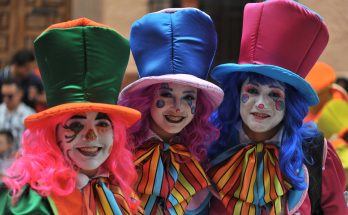By Rodrigo Díaz Guerrero
Local lore says that the Candelaria Fair tradition has been in our city for more than a hundred years and that it was called «La Fiesta de las Flores.» People gathered to exchange plants on Candlemas Day in streets and churches (later in the portals of the main garden). The custom took root, and for 67 years, the Candelaria Fair has grown and preserved its natural spirit. For two weeks, the sale of plants, flowers, pots, soil, and fertilizers from nurseries and exhibitors from across the country takes place, and cultural and artistic events are held, such as regional music concerts and dance group presentations by local talent and invited groups from other states in the Republic.
But something that is most relevant for participants at the Candelaria Fair is the indisputable reason for its existence, the religious component. It begins with the wake event from the night of February 1 to the dawn of the next day, during which groups of concheros (traditional dancers) come from all over the state. Moved by spiritual conviction, they arrive at Benito Juárez Park with songs, jaranas (revelry), copal, and other materials to make beautiful súchiles, altarpieces constructed mainly of cucharilla (a regional plant).
These constructions are placed on and around the cross in the park as religious offerings. The activities continue until sunrise. The Velación is an event at which the attendees perform a thanksgiving and veneration ceremony of with songs and praises, rituals, and prayers to the Holy Cross and the Virgin of Candelaria.
An evening unfolds with Mexican syncretism living in its maximum expression: the smell of copal; the sound of ancestral chants; the weaving of the retablos (altarpieces) by expert hands; the green, red, and sweet tamales, and the atole served and drunk to warm the body. All of this makes those who witness the activities feel swept away by the gale of time and history and the richness of a tradition to be admired and cared for because it is part of Mexican identity.
The journey continues. The next morning, after the traditional mass in San Antonio parish church, the exhibitors ceremonially bless the plants and seeds to predict a good harvest as soon as spring begins and the work in the fields starts. A company of the concheros is present from Valle del Maíz to perform pre-Hispanic dances, and delegates from different invited communities also participate.
The 67th Candelaria Fair will be held from February 1 to 15. It will be an inevitable magnet for hundreds of people attracted by the sale of plants, flowers, and gardening supplies. Cultural and artistic programs will also take place on stages erected for the occasion. But, in addition to all of this, we urge the reader to penetrate into the heart of the Fair, to witness the wake and participate in an ancient tradition in close ties with the community and history, and to take away an indelible memory, like the aroma and color of the flowers, which have been cared for since the blessing of the seed.




